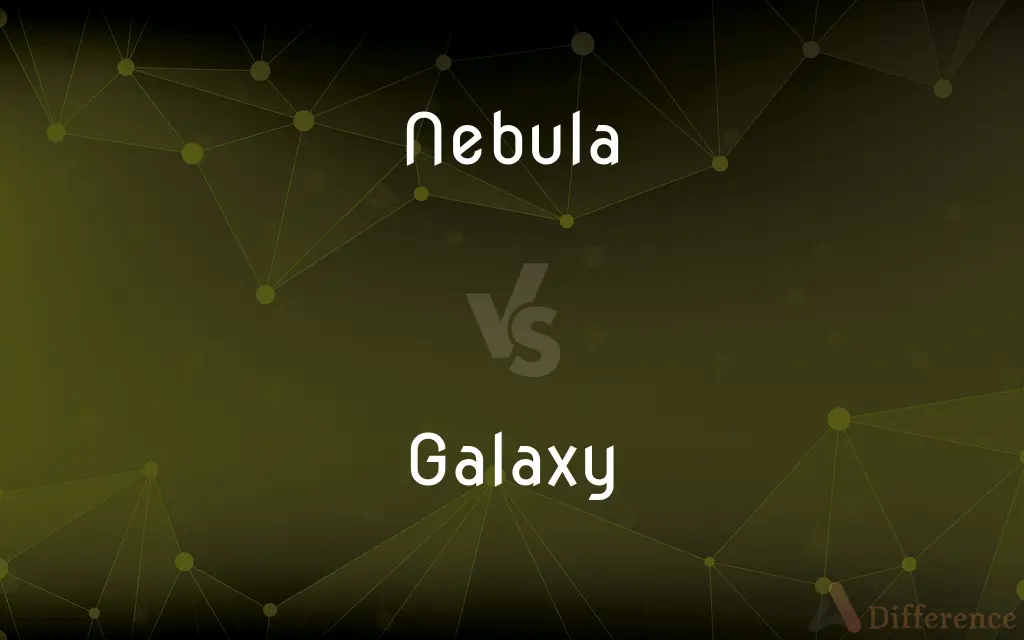Nebula vs. Galaxy — What's the Difference?
By Tayyaba Rehman — Updated on October 30, 2023
A Nebula is a vast cloud of gas and dust in space, while a Galaxy is a massive system of stars, gas, dust, and dark matter bound together by gravity.

Difference Between Nebula and Galaxy
Table of Contents
ADVERTISEMENT
Key Differences
A Nebula, in the vastness of space, represents immense clouds made primarily of gas and dust. They are often the birthplaces of stars, providing the necessary materials for star formation. On the other hand, a Galaxy encompasses a much grander scale. It is a vast system containing billions, often trillions, of stars, along with their planets, gas, dust, and a mysterious component called dark matter.
While Nebulae can be found within Galaxies, serving as stellar nurseries, the Galaxy itself is a collection of all these stars, planetary systems, and other celestial structures bound together by gravity.
Nebulae can have various forms, such as emission, reflection, and dark nebulae, depending on their composition and the kind of light they emit or absorb. In contrast, Galaxies come in different shapes like spiral, elliptical, and irregular, determined by their star distribution, history, and gravitational interactions.
To summarize, while both Nebulae and Galaxies are fundamental celestial entities, a Nebula is more like a chapter in the story of star formation, whereas a Galaxy is the entire book, chronicling a vast collection of stellar and interstellar tales.
Comparison Chart
Basic Definition
Cloud of gas and dust in space.
Massive system of stars, gas, dust, and dark matter.
ADVERTISEMENT
Size
Generally smaller than galaxies.
Encompasses vast regions, much larger than nebulae.
Main Components
Primarily gas and dust.
Stars, planets, gas, dust, dark matter.
Role in Space
Often serves as the birthplace of stars.
Contains billions to trillions of stars and their systems.
Typical Forms/Shapes
Emission, reflection, dark nebulae, etc.
Spiral, elliptical, irregular, etc.
Compare with Definitions
Nebula
Nebulae are often regions where new stars form.
Within the Nebula, the intense pressure causes gas and dust to form new stars.
Galaxy
A Galaxy can contain multiple star systems, clusters, and nebulae.
Our Galaxy has numerous star clusters and nebulae within its bounds.
Nebula
A Nebula can emit, reflect, or absorb light.
The emission from the Nebula gives it a glowing appearance in space.
Galaxy
A Galaxy contains billions to trillions of stars bound by gravity.
The Milky Way is the Galaxy that houses our solar system.
Nebula
A nebula (Latin for 'cloud' or 'fog'; pl. nebulae, nebulæ or nebulas) is an interstellar cloud of dust, hydrogen, helium and other ionized gases.
Galaxy
Dark matter is a significant component of a Galaxy's mass.
The gravitational effects in our Galaxy suggest the presence of unseen dark matter.
Nebula
A cloud of gas and dust in outer space, visible in the night sky either as an indistinct bright patch or as a dark silhouette against other luminous matter.
Galaxy
A galaxy is a gravitationally bound system of stars, stellar remnants, interstellar gas, dust, and dark matter. The word galaxy is derived from the Greek galaxias (γαλαξίας), literally "milky", a reference to the Milky Way.
Nebula
A clouded spot on the cornea causing defective vision.
Galaxy
A system of millions or billions of stars, together with gas and dust, held together by gravitational attraction.
Nebula
A diffuse cloud of interstellar dust or gas or both, visible as luminous patches or areas of darkness depending on the way the mass absorbs or reflects incident light or emits its own light.
Galaxy
Any of numerous large-scale aggregates of stars, gas, and dust that constitute the universe, containing an average of 100 billion (1011) solar masses and ranging in diameter from 1,500 to 300,000 light-years.
Nebula
A galaxy. No longer in technical use.
Galaxy
Often Galaxy The Milky Way.
Nebula
A cloudy spot on the cornea.
Galaxy
An assembly of brilliant, glamorous, or distinguished persons or things
A galaxy of theatrical performers.
Nebula
A liquid preparation for use in a nebulizer.
Galaxy
The Milky Way; the apparent band of concentrated stars which appears in the night sky over earth.
Nebula
(astronomy) A cloud in outer space consisting of gas or dust (e.g. a cloud formed after a star explodes).
Galaxy
(galaxy) Any of the collections of many millions or billions of stars, galactic dust, black holes, etc. existing as independent and coherent systems, of which there are billions in the known universe.
Nebula
A white spot or slight opacity of the cornea.
Galaxy
(figuratively) An assemblage of things or people seen as luminous or brilliant.
Nebula
A cloudy appearance in the urine.
Galaxy
Any print or pattern reminiscent of a galaxy, generally consisting of blending, semiopaque patches of vibrant color on a dark background.
Nebula
A faint, cloudlike, self-luminous mass of matter situated beyond the solar system among the stars. The term was originally applied to any diffuse luminous region. Now, technically, it is applied to interstellar clouds of dust and gases (diffuse nebula). However distant galaxies and very distant star clusters often appear like them in the telescope, such as the spiral nebula in Andromeda, known now to be a distant galaxy.
Galaxy
To furnish with galaxies.
Nebula
A white spot or a slight opacity of the cornea.
Galaxy
(archaic) To gather together into a luminous whole.
Nebula
A medicinal liquid preparation intended for use in an atomizer
Galaxy
The Milky Way, that luminous tract, or belt, which is seen at night stretching across the heavens, and which is composed of innumerable stars, so distant and blended as to be distinguishable only with the telescope.
Nebula
Cloudiness of the urine
Galaxy
A very large collection of stars comparable in size to the Milky Way system, held together by gravitational force and separated from other such star systems by large distances of mostly empty space. Galaxies vary widely in shape and size, the most common nearby galaxies being over 70,000 light years in diameter and separated from each other by even larger distances. The number of stars in one galaxy varies, and may extend into the hundreds of billions.
Nebula
An immense cloud of gas (mainly hydrogen) and dust in interstellar space
Galaxy
A splendid or impressive assemblage of persons or things; as, a galaxy of movie stars.
Nebula
(pathology) a faint cloudy spot on the cornea
Galaxy
A splendid assemblage (especially of famous people)
Nebula
A Nebula is a vast cloud of interstellar gas and dust.
The Orion Nebula is one of the brightest nebulae visible to the naked eye.
Galaxy
Tufted evergreen perennial herb having spikes of tiny white flowers and glossy green round to heart-shaped leaves that become coppery to maroon or purplish in fall
Nebula
Some Nebulae are remnants of dead or dying stars.
The Crab Nebula was formed from a supernova explosion.
Galaxy
(astronomy) a collection of star systems; any of the billions of systems each having many stars and nebulae and dust;
`extragalactic nebula' is a former name for `galaxy'
Nebula
Nebulae can be illuminated by nearby stars.
The bright star near the center illuminates the entire Nebula.
Galaxy
Galaxies can have spiral, elliptical, or irregular shapes.
The Andromeda Galaxy is a spiral Galaxy, similar to the Milky Way.
Galaxy
Galaxies are often part of larger cosmic structures called galaxy clusters.
Our Galaxy is part of the Local Group, a cluster of galaxies.
Common Curiosities
What shapes can Galaxies take on?
Galaxies can be spiral, elliptical, or irregular in shape.
What causes the colorful displays of some Nebulae?
The colors in Nebulae are often due to the emission of light from ionized gases or the reflection of light from nearby stars.
How is a Galaxy different from a star cluster?
A Galaxy contains billions to trillions of stars, while a star cluster is a smaller grouping of stars, often within a Galaxy.
Are Nebulae solid structures?
No, Nebulae are vast, diffuse clouds of gas and dust, not solid.
Do all Galaxies contain Nebulae?
Most Galaxies, especially those actively forming stars, contain Nebulae. However, the number and type can vary.
Are there different types of Nebulae?
Yes, there are various types, including emission, reflection, and dark nebulae.
How do Nebulae play a role in star formation?
Nebulae provide the necessary gas and dust for the formation of new stars.
How many stars can a typical Galaxy contain?
A typical Galaxy can contain anywhere from billions to trillions of stars.
How large can a Nebula be?
Nebulae can vary widely in size, from a few light-years across to hundreds of light-years in diameter.
What primarily makes up a Nebula?
A Nebula is primarily made up of gas and dust in space.
Can Nebulae be found outside of Galaxies?
Typically, Nebulae are found within Galaxies, serving as regions of star formation.
How do we know dark matter exists in a Galaxy?
While dark matter doesn't emit light, its presence is inferred from gravitational effects on visible matter in a Galaxy.
Can Galaxies merge with each other?
Yes, Galaxies, especially those in close proximity, can merge due to gravitational interactions, often forming a larger Galaxy.
Can a Nebula evolve over time?
Yes, as stars form or die within a Nebula, its composition and appearance can change.
How are Galaxies distributed in the universe?
Galaxies are part of larger structures like clusters and superclusters, forming a cosmic web in the universe.
Share Your Discovery

Previous Comparison
Persuadable vs. Persuasible
Next Comparison
Signalled vs. SignaledAuthor Spotlight
Written by
Tayyaba RehmanTayyaba Rehman is a distinguished writer, currently serving as a primary contributor to askdifference.com. As a researcher in semantics and etymology, Tayyaba's passion for the complexity of languages and their distinctions has found a perfect home on the platform. Tayyaba delves into the intricacies of language, distinguishing between commonly confused words and phrases, thereby providing clarity for readers worldwide.















































